Nicole Field's Blog
October 12, 2025
Aspec Polyamory & Autism 2
I’ve been working on a multi-chapter essay on polyamory through an asexual lens for over a year. There’s so much I want to include in it but the reality is: not all of it will fit. Some of it’s too personal for an academic essay. Some of it is tangential. Some of it’s straight up the result of delving into autistic hyperfocus down a rabbit hole that’s too far gone to be deemed anywhere near relevant.
So I bring to you a blog series I’m calling Acespec Polyamory & Autism (APaA), to keep always front and centre the focus I have on de-centring sex from my discussions on polyamory, alongside the other significant lens through which I view this work.
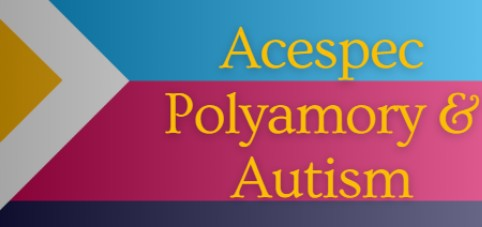
In which we cover Asexual Academic Spaces, Queer Time Theory, A Dowry of Blood and Other Vampire Centered Stories.
I recently came across Ell Huang’s post on the intersection between Anne Rice’s “Interview with the Vampire and Asexual Loneliness” when I was already thinking about the polyamorous depiction of a dysfunctional family as depicted in S. T. Gibson’s skillful Dracula retelling, A Dowry of Blood. And, gosh, I’m glad I did.
This isn’t the first time I’ve read something in the asexual academic space and seen clearly a line between what I’m writing and what others in one of my communities have been working on.
Earlier in the year, I read and loved Dr. Noah O’Connor’s post-graduate thesis Asexuality in Young Adult Fiction.
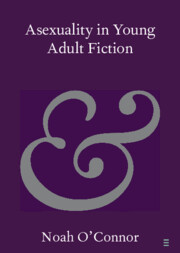
(Cover art for Noah O’Connor’s Asexuality in YA Fiction.)
This time was slightly different as Huang’s essay left me with so many threads of connection I wanted to make, and not just between the asexuality in Interview With the Vampire, and the polyamory in A Dowry of Blood.
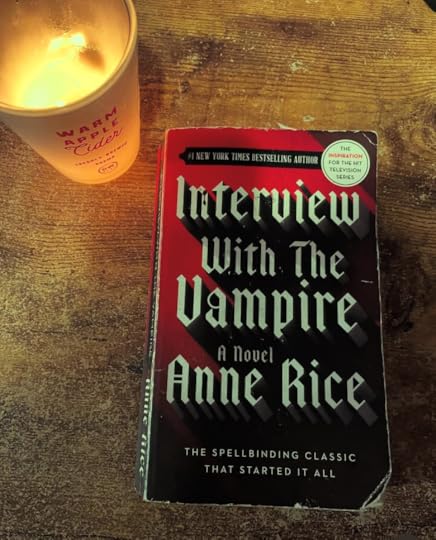
The vampires [of Interview With the Vampire] no longer repopulate as humans do and do not have a traditional sex drive. They no longer have marriage nor death, and they no longer measure time by the same milestones as humans do. Yet in their immortality, there is an urgency to build their own version of companionship/family because they are unfathomably socially starved.
(Image & text credit to Ell Huang, 2025)
Vampires being socially starved is something we see in a straight line from Dracula to Interview With the Vampire to A Dowry of Blood.
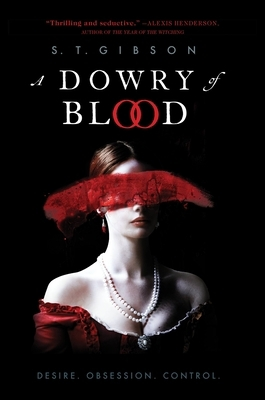
(Cover art for S. T. Gibson’s A Dowry of Blood, 2021)
I began writing the above sentence with an addendum that, in Dracula, we have the vampire as the unrepentant monster. But the same thing is true in both Interview With the Vampire and A Dowry of Blood. Both of them are vampire stories for vampires.
That is: they are not narratives deliberately softened to accommodate the human reader or the human / vampire romance (A Dowry of Blood also deviates significantly from Lucy Undyingby Kiersten White; a Dracula retelling published three years later, retelling the story of Lucy Westenra who falls in love with a human girl and keeps her safe as she was not kept safe).
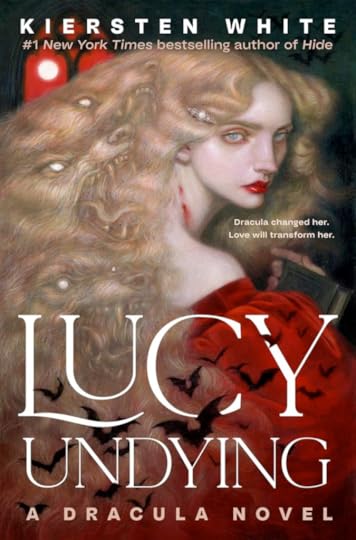
(Cover art for Kiersten White’s Lucy Undying, 2024)
In these vampire novels with such a strict separation from the human race out of which they were plucked, we see that traditional sex life, marriage and social interactions are all completely obliterated.
Huang highlights this passage from Interview With the Vampire to make the point of Anne Rice’s typically asexual vampires.
“I felt a longing for him so strong that it took all my strength to contain it, merely to sit there gazing at him, fighting it […] Not physical love, you must understand.” (Rice, 254)
With S. T. Gibson’s vampires, traditional sex life is also turned on its head, but in the opposite direction. The vampires in Interview With the Vampire may form chosen family groups, but they will have one committed and asexual relationship (at a time) with others of their kind. Meanwhile, the vampires in A Dowry of Blood form sexual relationships with every part of their chosen family group.
As other commentators of this book have commented, this does not make A Dowry of Blood erotica.
I want to be clear this is not erotica. If it wasn’t for all the vampire feeding blood, I’d say it could probably pull off a PG13 rating for the sexual content. A lot occurs off-screen or is only vaguely described. […] This in fact is not a story about sex but one about many centuries of abuse and how the persons being victimized finally break free.
From book review by Opinions of a Wolf (Oct 2022).
The infamous brides of Dracula are, by their nature, in a controversial marriage that rails against the traditional. In these pages, Constanta, Magdalena and Alexi are depicted as well as named in all their glory. I particularly liked that Alexi, a man, rounded out the third of these brides.
As to social isolation? Regardless that Dracula is never named, he’s often described as being gone to find his latest conquest. Meanwhile, his wives are to remain satisfied with only the company that Dracula gives them. Despite the fact that he plucks out individuals from amongst humans to turn and join them, none of them must ever do the same.
Huang makes a similar point as to the several layers of Lestat’s social isolation techniques when it comes to Louis and Claudia in Interview with the Vampire:
Lestat, the maker of both Louis and Claudia, exerts a narcissistic, deceitful control over what they know as normal vampire life. He makes them break sacred vampire law by turning Claudia at such a young age, and lies to them to keep them from other vampire community, insistent that he is all they have.
From “Interview with the Vampire and Asexual Loneliness” by Ell Huang (Oct 2025).
But here’s the difference: The free online short, An Encore of Roses takes place after the events of A Dowry of Roses. This short story offers a particularly unique glance into an established polyamorous relationship.
Constanta, Magdalena and Alexi have been in a triad for the three decades that have passed since they were all last in the same place together in addition to the years spent together during A Dowry of Roses. They are far past their honeymoon period and well into the era of juggling other relationships and managing feelings of jealousy and being left out that arise therein.
Of honeymoon periods, Janet Hardy and Dossie Easton observe, in The Ethical Slut:
Every relationship has a honeymoon phase, and honeymoons do not last forever. Some people get addicted to the honeymoon […] and wind up flying from partner to partner, always imagining that the next partner will be the perfect one.
This story accurately portrays some of the insecurities that are common in polyamory, as well as the importance of ongoing communication – especially when faced with immortality.
But, whatever Alexi’s fears, it’s clear being left by his vampire lovers is on the cards for him in An Encore of Roses. Before they can be physical with one another, Constanta notices Alexi’s preoccupation and takes it for an opportunity to talk through and resolve some miscommunications.
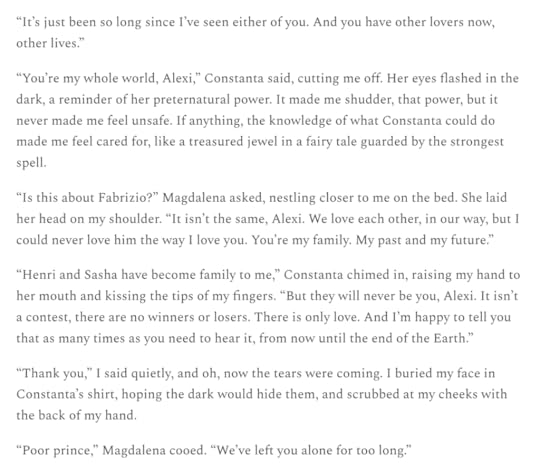
From An Encore of Roses.
Through reading “Interview with the Vampire and Asexual Loneliness”, I also came across the concept of Queer Time Theory, which started me on a rabbit hole that officially started with reading this essay, before devolving to Queer Time, to Judith Halbertstam, to Michael Foucault, to multiplicity, to… Well. You get the point.
For me as a bisexual I feel like I experience two stands of time; my progression with dating people that don’t identify as men has been far behind than my progression with dating men, which has evolved in a fairly ‘normal’ way.
[…] whereas I could be open about having crushes on guys from the moment I first had them […] I didn’t even come out to myself as bisexual for another 4 years.
From The comfort of Queer Time Theory, by Meg Hopkins (July 2021)
Some trans people say that gender transition is like becoming a teenager again: going backwards in time but also kinda different. If your transition involves surgeries or hormones, there’s often a lot of waiting to access those things with no idea how long you’ll be waiting, so the future can weigh heavily on the present.
There can be a sense of lost time, as well. A childhood that you never got to have. The possibility that somebody who’s literally younger than you might be a senior trans person because they’ve been out for longer.
From Queer | Philosophy Tube, by Abigail Thorn (Oct 2019)
| Philosophy Tube, by Abigail Thorn (Oct 2019)
These were the two most poignant descriptions I found during my time in the rabbit hole on Queer Time, and it’s because of that personal narration.
Of Queer Time in her Queer Temporarility and Postmodern Geographies (2005), Judith Halbertstam adds to this,
Queer time perhaps emerges most spectacularly, at the end of the twentieth century, from within those gay communities whose horizons of possibility have been severely diminished by the AIDS epidemic […] it is also about the potentiality of a life unscripted by the conventions of family, inheritance, and child rearing. (Halbertstam, 2)
Whiiiiiich brings us neatly back to AIDS and also to this excerpt from Heaven’s Cost: A Memoir by Mark Doty published after his partner died of AIDS: “All my life I’ve lived with a future which constantly diminishes but never vanishes.” (Doty, 4)
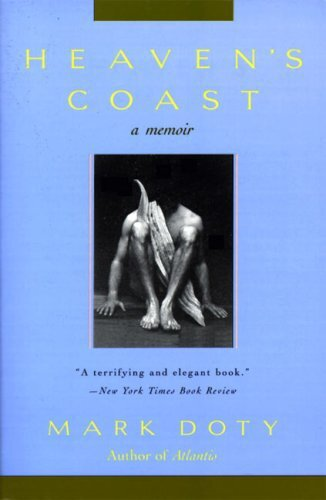
(Cover art for Heaven’s Coast by Mark Doty, 1996)
All of this got me thinking about my own experiences in relation to Queer Time. Polyamory does, after all, come under the QUILTBAG umbrella. (Ed: I realise even as I write this that my favourite written version of the LGBT+ acronym does NOT, in fact, include the polyamorous/pansexual “P”.)
Ahem, the LGBTIAQP+ umbrella.
Writings of Michael Foucault, Judith Butler and other Queer Theorists, Queer Narrative Theory, all factor into polyamory and polyamorous narratives in ways that are consistent to the ways in which they’ve already been applied to other assorted QUILTBAG communities.
And that is, after all, the umbrella of the argument I’m working on. But there are already existing a small handful of stories that take the idea of polyamory in terms of the conventions of family and what changes if the parents are polyamorous – and what stays the same – such as Dax Murray’s A Lake of Feathers and Moonbeams, V. E. Schwab’s The Fragile Threads of Powerand The Other Side of the Sky by Amie Kaufman and Meagan Spooner.
October 2, 2025
Acespec Polyamory & Autism
I’ve been working on a multi-chapter essay on polyamory through an asexual lens for over a year. There’s so much I want to include in it but the reality is: not all of it will fit. Some of it’s too personal for an academic essay. Some of it is tangential. Some of it’s straight up the result of delving into autistic hyperfocus down a rabbit hole that’s too far gone to be deemed anywhere near relevant.
But all these ideas still take up space in my mind, wanting to be shared. I want to share them. And I wonder if making a series detailing the thoughts behind the work of this essay on polyamory stories – giving space for those thoughts and inevitable rabbit holes (let’s face it, they’re a feature of the autistic experience, not a bug) – will be of interest to anyone else.
And whether its absence will make the academic writing more clear.
So I bring to you this upcoming blog series called Acespec Polyamory & Autism (APaA), to keep always front and centre the focus I have on de-centring sex from my discussions on polyamory, alongside the other significant lens through which I view this work.
Let’s begin!
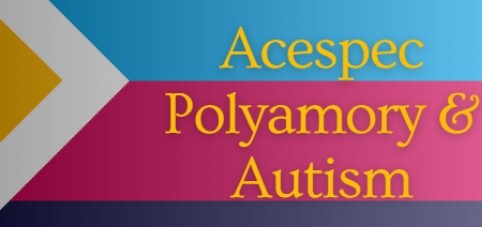
In which we cover AIDS, Rabbit Holes, 90s Queer Theory (at a glance) and the Pros and Cons of Representation.
In 1983, AIDS is in full swing (I promised rabbit holes and here I am delivering with spectacular success right out of the gate!) The CDC is attempting to protect the nation’s blood supply. They still don’t know how it’s being transmitted despite the fact that it’s been being blamed on the gay community for years.
This moment in time/queer history is tangentially relevant to not one but two of my writing projects, actually, the second one being my vampire story that crosses creature horror with the real life horror of this blood-born virus.
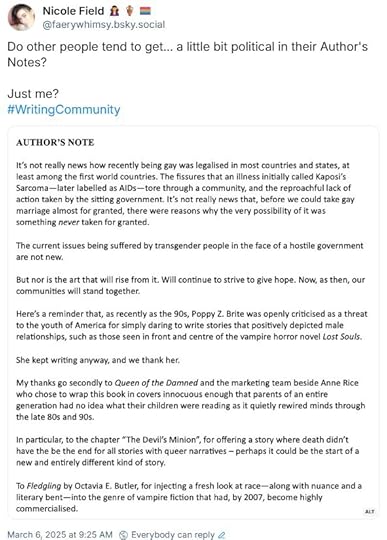
By 1987, my ABC cartoons were interrupted by what’s still viewed today as one of the grimmest advertisements filmed during the AIDS crisis. Naturally, I had questions, even if I can’t remember the answers so vividly as I can remember the impact of this ad campaign (Ed: The style of this campaign was apparently suggested to be revisited during the Covid-19 pandemic, but more on the connection between these two outbreaks shortly).
Out of 1992-3 would emerge the Lesbian Avengers, which Abigail Thorn details well in this episode of Philosophy Tube. Around this sprung a great deal of the Queer Theory canon. (Ed: Shortly is now. In something not remotely ironic, the video to automatically play after this one was this exclusive from six months ago that opens with the line, “Trump’s America has started to challenge and redefine academic freedom”, thus closing the loop of hostile government [Trump/Reagan] + global health crisis [Covid-19/AIDS] that links the past half a decade to most of the 80s for me.)
In 1997, being gay was finally de-criminalised in Tasmania, a state that before this point, as Hannah Gatsby put it, had been of the opinion that queer people should “pack up your AIDS in a suitcase and fuck off to Mardi Gras.” Funnily enough, this is also the year that the first edition of what would go on to be the so-called “poly bible”, The Ethical Slut, was released in first edition by Greenery Press.
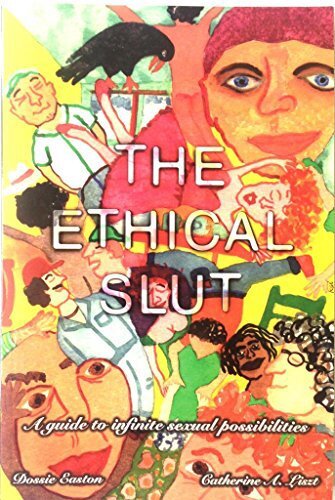
(1997 cover of the first edition of The Ethical Slut.)
Meanwhile, this was the year I turned 15.
2 years later, a friend would tell me she was a lesbian after a particularly hurtful experience with her first boyfriend. A year after that, a friend would ask me, “But are you gay or straight?” and I would reply, “I don’t know.”
I don’t know.
I did know. I knew I had two cousins who were queer. I knew from my grandmother that it was all right for me to bring a girl home if that was the reason I’d never brought home a boyfriend. This was followed with a statement I’ve never forgotten and echoed mockingly in story many times, “Just so long as you’re not one of those bi people.“
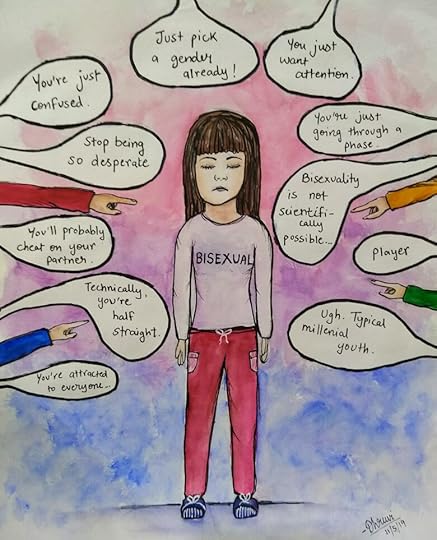
(Image on biphobia taken from Wiki.)
All I knew of “bi people” was early internalised biphobia. They were supposed to be greedy, right? Greedy about what? Well, about sex, I guess. So, that was no problem to me since I’d never experienced any sexual attraction to anyone.
Only problem was… I already knew I couldn’t say the same of romantic attraction.
In 2002, I proudly proclaimed that it didn’t make sense to me to be interested in people of multiple genders and not date representatives of each of these genders at the same time, should the opportunity arise. In so proclaiming, I managed to put myself inescapably into a very sex oriented spere despite myself.
Except, in 2002, there wasn’t a whole lot of sex explicitly connected to either my idea of what I was going to do, or the feedback I had from friends. Hell, in 2002, I vividly remember the term I used for the relationship style I was most drawn to was “open” (as opposed, of course, to “closed”) because I hadn’t come across the term “polyamory” yet.
Ahhh yes, we’re finally here. To the polyamory. Thank you for sticking around.
In the video above, Abigail talks about the conversations being had in the 90s over the pros and cons of lesbian activists getting a lot more representation. It was then linked to the same conversations being had in 2019 by trans and non-binary people when this episode originally aired.
When I first heard that, I thought… “When are we going to see that same thing for polyamory, and be able to ask those questions too?”
But the more I thought about it, the more I realise… we have. And we are. And, just like those 90s lesbian activists, and our trans and non-binary siblings before us, I find myself wondering over the pros and cons of having a lot more representation.
In 2002, I hadn’t yet heard the word polyamory. That would change by 2004, yet would still be rather sexless because there wasn’t exactly a widespread consensus of what exactly polyamory was as a movement beyond some kind of consensual non-monogamy. If one looked a little further, they might be able to find that, just like the pronoun “they”, there is a long historical precedent for non-monogamy.
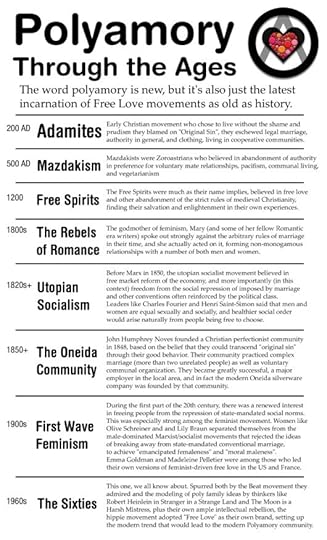
(Infographic on polyamory through the ages.)
These days, if you ask five polyamorous people what polyamory is, you’ll get five different answers (honestly, this isn’t so similar to both autism and asexuality, it’s got me thinking on the possibility of a polyamorous… spectrum.)
But if you ask anyone else, the answer will almost always include sex.
August 18, 2020
Corey Alexander & Xan West
I guess I’m posting this because there’s a part of me that can’t quite believe I’m not going to get to have another conversation with them, that no one is going to get to talk to them about books, or kink, or autism, or being Jewish, or anything else.

But there is one thing I do know: This isn’t the end of peoples’ writing being influenced by Corey Alexander. That part, at least, gets to live on with us.
Two years ago, I came out of a really hard relationship, and they were there for me.
They said: It’s okay to be where you’re at, and I have not forgotten.
It inspired the following piece of writing, which I feel is relevant again today.
Little rituals, they said to me. It’s hard to break the habits straight away. You’re used to them. And this isn’t stepping away. Honouring and observing structure is being true to your heart.
Start slow.
I’m starting slow. Honouring myself. Kneeling beside my wooden desk, where my boots have sat for weeks, untouched. Breathing in that unbelievably familiar scent. How did it become so familiar? Leather never mattered to me before.
Oh.
Oh. And that’s okay. Breathe it through. In, then out.
These boots are sitting in the shadow cast by my desk. They are the protectors of my ankles. They hug me close to the foot. They are little witchy boots that keep me walking on the path. They are mine.
The cool wood against my forehead feels like it’s holding me in place. Not rushing forward, nor rocking back. The wood isn’t a warm hand. It’s not breathing in time with another person. It isn’t a lot of things.
But it is this moment. I am in this moment. Cool wood, and soft leather, and I am calm. I am centred.
I am pleased with who I see in my innermost self. I have learned, and grown, and I am so proud of that. I have kept a daily journal. I will continue to do so. When the pages of that journal run out, this period of my life will be over and I will enter into a new one.
And that’s okay.
Breathe. In, then out.
Cool wood and soft leather, and I am smiling against the boot’s purple laces.
I know myself. I know myself better than I have ever known myself before, and I will continue to know myself better today. And I will continue to know myself better tomorrow.
Cool wood and soft leather.
I am exactly where I need to be.
August 12, 2020
Blog Series: Spotlight on Girl, Serpent, Thorn by Melissa
I will admit, I have been excited about this upcoming novel since reading Girls Made of Snow and Glass last year. Where the last one was much more standard European and Snow White influenced, this one was Persian specific and ever so slightly Sleeping Beauty based.
Quite a difference in writing style, but just as enjoyable.
 Soraya is a princess with poison in her skin. It is a demon curse that was passed to her by her mother for reasons that Soraya does not understand for about half of the story. However, there is a story that the queen tells her over and over again which explains a version of the truth and is all Soraya has to hold onto when the rest of the royal family leave and basically abandon her for months out of the year. Being poison, after all, would be a shame on the royal family who is meant to be able to protect all of its people and especially its princess!
Soraya is a princess with poison in her skin. It is a demon curse that was passed to her by her mother for reasons that Soraya does not understand for about half of the story. However, there is a story that the queen tells her over and over again which explains a version of the truth and is all Soraya has to hold onto when the rest of the royal family leave and basically abandon her for months out of the year. Being poison, after all, would be a shame on the royal family who is meant to be able to protect all of its people and especially its princess!
All of this changes when Soraya’s brother returns to the palace with a demon prisoner in tow. A demon who, Soraya thinks, may actually have some of the answers to the questions she’s seeking regarding her curse.
This novel has multiple layers of intrigue going all the way through it. There was a time when I thought that the f/f content note I’d made for myself was actually mistaken. But, no! There is definitely f/f content and the build is very slow to get going but it is satisfying.
All of the plot pacing moments were fantastic, and I’m just a sucker for any kind of mythology or fairy tale retelling. So not surprisingly, with two of my favourite story elements as well as fantastic writing, this was a 5 star read for me.
August 11, 2020
Blog Series: Spotlight on Pillow Thoughts by Courtney Peppernell
This book is split up into 10 sections, acknowledged on the back of the book as, “to read when you feel you need them most”.
For me, the first two sections, ‘If you are dreaming of someone’ and ‘If you are in love’ need to be read all the time. They are both so beautiful and calming and whimsical and just felt like balm on my soul. I loved them a lot.
 The first one to give me the heartbreak feels was ‘If you are heartbroken’, so it definitely hit the right notes of nostalgia, pain, loss and the rest of those. But what I loved was the lack of critique. Mourning without demonising. There was a sense of realism to these poems that made them feel like they actually were accessible to everyone.
The first one to give me the heartbreak feels was ‘If you are heartbroken’, so it definitely hit the right notes of nostalgia, pain, loss and the rest of those. But what I loved was the lack of critique. Mourning without demonising. There was a sense of realism to these poems that made them feel like they actually were accessible to everyone.
Out of the section, ‘If you are feeling lonely’, the first line utterly slayed me:
How does loneliness still exist with all these souls in the world?
So much of this poetry collection was something I could absolutely identify with.
When we get to the section of ‘If you are missing someone’, I was doing okay actually, all the way up to this point:
And take the air from my lungs
My head starts pounding
And I just want to kiss you
It’s midnight
And I just want you.
I will admit, I was a bit worried about coming into the section titled ‘If you need a reason to stay’, only because a lot of the rest of it had been relationship centric. And sometimes relationships are not things you want or need to stay in. But this part wasn’t about relationships. It was filled with beautiful things about the world and one’s experience of it that would encourage an individual to stay here in this world, which I just thought was both beautiful and beautifully done.
So often, Courtney’s poetry manages to be incredibly simple and yet at the same time beautiful. She artistically uses rhyme and repetition to get points across in very accessible prose. This is definitely a poet I’ll be reading more of.
July 19, 2020
Blog Series: Spotlight on ‘As I Descended’ by Robin Talley
It’s taken me a good long time to get around to reading this one — too long. I heard ages ago that it was a teen f/f version of Macbeth and, well, that sold me. Thankfully, it was also available on my ebook library during lockdown so that when I finally decided it was time to pick it up, it was right there!
I could not wait to see what a gay novelisation of this play would look like.
 The first thing I want to say is that I completely underestimated how gut wrenching it would be. Not just having the words and the actions of the players, but being given the inner thoughts of Maria, her partner Lily and best friend Brandon (Macbeth, Lady Macbeth, Banquo). We get all three of their points of view through the prologue which is basically a seance with a Ouija board within the boarding school the three of them live in.
The first thing I want to say is that I completely underestimated how gut wrenching it would be. Not just having the words and the actions of the players, but being given the inner thoughts of Maria, her partner Lily and best friend Brandon (Macbeth, Lady Macbeth, Banquo). We get all three of their points of view through the prologue which is basically a seance with a Ouija board within the boarding school the three of them live in.
As with the original play, the outcome of this night has spiralling repercussions that influence the rest of the whole novel.
Maria believes in the spirits whole heartedly. She goes into a bit of a trance while the others transcribe and try to make sense of what is happening. Lily is far more laid back about the seance itself. However, she wants more than anything for Maria to get a scholarship that is currently likely to land on the shoulders of the current self proclaimed queen of the senior class, Delilah (King Duncan). To that end, Lily manipulates it so as to get Delilah out of the running and using Maria’s belief in the spirits’ will to have her act in the way Lily wants her to.
This much of the story takes up almost the first half of the book, introducing all the characters and dynamics at play within the school, really setting up this story so that people who haven’t come across Macbeth before will be able to read it as its own text. It’s incredibly well done.
However, it also has the effect of making the rest of the story which has to fit into half of a novel come really fast, one thing after another, which ultimately adds to that whole feeling of things spiralling out of control.
It was honestly a fantastic and thrilling adaptation.
July 18, 2020
Roots Before Branches: July in 2020
At the beginning of this year, I came to a sudden realisation that I had achieved the writing goals that I had set out in my head since my earliest memories. I had a shelf of books that had been published with my name on them. Below that, I had a shelf filled with awards and the tertiary qualifications I had taken time to achieve at various institutions leading up to that.
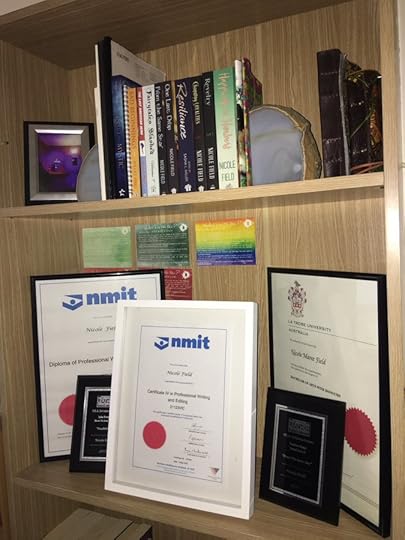
I had a whole little setting on my upstairs landing of what I had achieved in my humble little life thus far. I was proud of it. I was happy.
And I also felt done.
I knew that I had work coming up in anthologies around the place, each of them highlighting important / intrinsic parts of my life and journey.
Non-binary gender – Climbing Lightly Through Forests, edited by R. Lemberg and Lisa Bradley
Asexuality – Best Lesbian Erotica vol. 5, edited by Sinclair Sexsmith
Polyamory – Love All Year, edited by Elizabeth E
BDSM – Mastering the Art of Mastery, edited by Raven Kaldera
I’m proud of all these pieces of writing, and am excited to see them out in the world. But it was a struggle to consider anything of a full length that I might write for publication again.
[image error]
By May of this year, I realised I needed to put some thought into what writing meant for me now. A lot of the representation that I had wanted to see in books as a teenager in the 90s has come into being. There is no faster way for me to kill my boner for writing than to think of it in terms of marketability.
So where did any of this leave me?
There is a novel on writing by Elizabeth Gilbert called Big Magic. It’s a novel that effortlessly combines the creative process with a more spiritual one, and it’s one I’ve come back to over and over since its release in 2015. The belief that has lived within me since that first reading is this one:

“I believe that our planet is inhabited not only by animals and planets and bacteria and viruses, but also by ideas. Ideas are a disembodied, energetic life-form. They are completely separate from us, but capable of interacting with us–albeit strangely. Ideas have no material body, but they do have consciousness, and they most certainly have will. Ideas are driven by a single impulse: to be made manifest. And the only way an idea can be made manifest in our world is through collaboration with a human partner.
“When an idea thinks it has found somebody–say you–who might be able to bring it into the world, the idea will pay you a visit. It will try to get your attention. […] The idea will try to wave you down but when it finally realizes that you’re oblivious to its message, it will move on to someone else.
“But sometimes […] your defences might slacken and your anxieties might ease, and then magic can slip through. The idea, sensing your openness, will start to do its work on you. It will send the universal physical and emotional signals of inspiration.”
“And then, in a quiet moment, it will ask, ‘Do you want to work with me?'” (Big Magic, pages 34-36)
On Friday 10th July, after 5 months of writing nothing, I believe one of these ideas signalled me down while I was in the passenger seat, taking my Old Man Pupper to the vet for a tooth extraction (it ended up being 11 teeth instead of the expected 5, but that’s another story for another time).
I remember gazing out of the window, not thinking anything much, then suddenly gasping a breath in as the idea struck. What an inconvenient time! I thought to myself. I have things to do. I’m not able to get any writing done at the moment; we are 2 minutes away from the veterinary clinic.
And then a wonderful thing happened: The idea was still there when I woke up the following morning.
I don’t usually write on weekends. Those who know me well will know that I’ve managed to keep my writing habit from taking over my life in my more hyper-focused states by having an incredibly strict regime of writing. Not in the evenings unless I’ve been at work during the day, and not on weekends.
On Saturday morning, I asked my partner if he would mind if I broke my embargo on not weekend us-time writing given that it had been such a long draught between words.
I then proceeded to write 10k words. It was delightful. It was exhilarating. It was like flying from the seam of my pants and having a very hazy destination point in mind but not really worrying about how I was going to get there because I knew I was fully taken care of.
Me and the idea, we were going to take care of each other, that was a given.
Sunday morning, the only thing that changed is that we went out to the supermarket before I sat down and lost an entire other day what was becoming a burgeoning manuscript.
By Monday, I knew what the potential three acts would look like. On Tuesday, I woke up with a title in mind, taken from a Coldplay lyric.
By Wednesday, I finally began to slow down. This was important, it gave me a chance to get back to thinking of other things that needed to get done around the house, to having a video chat with a friend of mine, to read and allow more words into myself after this rather radical outpouring.
This weekend, both Saturday and Sunday, I have returned to my promise to self of not writing on weekends, but the idea is still there, curling up with me when I’m about to go to sleep and presenting ideas for upcoming scenes that I am putting down into notes in preparation for writing on Monday.
And so all of this has me thinking: What is it that’s different about this piece of writing? Why did I say yes to this idea when I’d said no to so many others for months? What is the tremendous pull of this particular collaboration between myself and idea?
I had a couple of initial thoughts:
having time in which to write
writing for fun
writing for myself
In reality, for me, it is none of these things.
The thing that thrills me about this story, the thing that excites me enough that the Word document is the first thing I go to rather than any web page, is one simple thing:
When this manuscript is complete, I will have a memento, a keepsake. This keepsake will be something I am proud to go back and read over whenever I want to.
Frankly, even incomplete it brings a smile to my face, and pleasure to my thoughts.
This, then, is the answer I’ve been looking to find for the last 3 months.
July 14, 2020
Blog Series: Spotlight on ‘Aphrodite Made Me Do It’ by Trista Mateer
I’ve steered away from reading contemporary poetry for the last little while because, after a bit, it all becomes a bit about people overcoming the trauma of their past relationships but acknowledging they aren’t the same afterwards. While this is an important story, it’s sad to me that there is so little contemporary poetry at the moment that really embraces themes outside of that.
The reason why this collection grabbed me was the title. I was hoping, and expecting, something like Goddess of the Hunt, which is another poetry collection that features heavily a goddess from Greek myth, or even Wild Embers.
 Instead of being purely focused on Aphrodite, this collection turned out to be a sort of conversation between Aphrodite and the poet, exploring the different things that they each had to say from their experiences of love, war and grievances in general. My favourite part was definitely looking back at the history of the goddess and seeing how that has been changed and cheapened to fit in with man’s definition of what it is to be feminine. I actually can’t overstate how much I loved that. It was such a strong way to begin this collection.
Instead of being purely focused on Aphrodite, this collection turned out to be a sort of conversation between Aphrodite and the poet, exploring the different things that they each had to say from their experiences of love, war and grievances in general. My favourite part was definitely looking back at the history of the goddess and seeing how that has been changed and cheapened to fit in with man’s definition of what it is to be feminine. I actually can’t overstate how much I loved that. It was such a strong way to begin this collection.
The downsides of this collection were mostly in the repetition of ‘I’ statements throughout. For most of it, this appeared like a way of separating the poet’s voice from Aphrodite’s, and at the end it was something that Aphrodite also adopted in her final section on war. I understand, I think, what this was trying to achieve. It was just a technique that didn’t work for me.
As is usual in a lot of these poetry collections, the list of trigger warnings are at the front and they include:
– body image
– sexual assault
– rape
– eating disorders
– queerphobia
– emotional abuse
– physical abuse
July 9, 2020
Blog Series: Spotlight on ‘Girls of Storm and Shadow’ by Natasha Ngan
I wanted to love this book so much more than I did, but sadly it really just suffered a great deal of middle book in the series slump.
 Having attempted to kill the king of Ikhara, Lei and Wren are on the run. With a group of allies, they are now trying to pull together a resistance worth speaking of to overcome the power imbalances in the Hidden Palace and to assure that Paper citizens will get better treatment and be treated like actual humans despite their lack of demon blood.
Having attempted to kill the king of Ikhara, Lei and Wren are on the run. With a group of allies, they are now trying to pull together a resistance worth speaking of to overcome the power imbalances in the Hidden Palace and to assure that Paper citizens will get better treatment and be treated like actual humans despite their lack of demon blood.
I understand that this book is about what happens in the aftermath of abuse, rape and trauma. A story about learning how to live with those things, paired with the backdrop of being in the midst of a wider war against your people. I think that those kinds of themes are super important and it’s great that they are being explored so openly and unapologetically.
It wasn’t the themes that I found difficult to grasp. It was the pacing. For me, this was a huge slog to get through, feeling similar to The Two Towers were the main cohort were trudging through lands trying to get to a particular destination at the end. The only points where I felt something in this novel were when characters I loved were either injured or killed.
I wanted to feel more in between these moments. Instead, I felt for a lot of this book that I was waiting for something to start.
June 29, 2020
Blog Series: Spotlight on ‘Honor Bound’ by Ann Aguirre and Rachel Caine
I don’t know how it’s possible, but this book was just as good as its predecessor. No signs of middle book slump in this trilogy!
Zara continues to be capable and kickass, but I do love the comment about halfway through this book that the ship Nadim is starting to pick up more of her brash traits and Zara is becoming calmer through Nadim’s influence. Their relationship continues to be beautiful, and the way their connective moments are described is easy to imagine and much more frequent than in the last book.
 As well the continuation of Zara and Bea becoming closer takes place here.
As well the continuation of Zara and Bea becoming closer takes place here.
At the same time, the Phage continue to be a big concern for the living Leviathan ships. This book picks up immediately where Honor Among Thieves left off. They are in the middle of the mass graveyard that the Phage have left.
And they are also quite close to the system of the Sliver, which is where the majority of the plot for this book takes place.
Meanwhile, on Earth, there’s this dude that’s pretty upset with the mess Zara left behind her and through the course of the novel, he sends Zara’s ex-boyfriend into space to intercept her. I expect we’ll see a lot more of that, as well as the conclusion of the Phage and their leader, in the final book.



